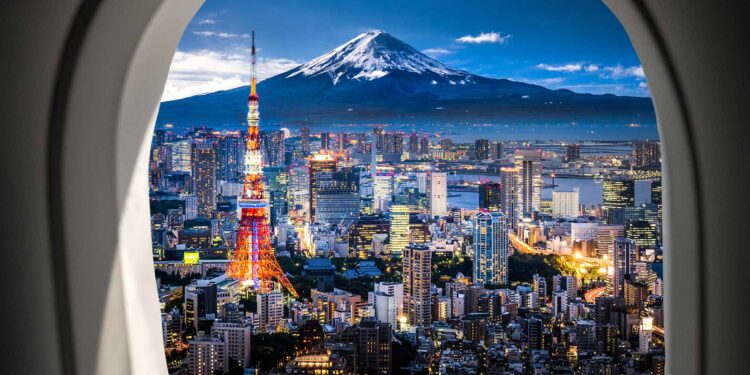Operating to Japan – Part 3: Ground Handling, Security & Local Services

This is a post by author Hiroshi Higashiyama. Hiroshi is representative director for Universal Aviation Japan, which has aircraft ground handling facilities in Haneda, Narita, Sapporo, and Osaka. Hiroshi is an expert on business aircraft operations in Japan and can be contacted at hiroshihigashiyama@universalaviation.aero.
This business aviation blog post continues from our article last week, entitled “Operating to Japan – Part 2: Permits, Slots & CIQ.”
Ground handling services in Japan are known for their reliability, quality and high level of customer care. Still, we recommend operators provide advance notification for all required services, fuel uplifts and in-flight catering to ensure any potential delays are avoided.
The following is an overview of what you need to know:
1. Handling services
Full general aviation (GA) support services are available at all airports of entry (AOEs) in Japan but options and procedures vary airport to airport. Handlers usually prefer 24 hours’ notice to set up services but this depends on location. It’s always best to forward a fuel release to your ground handler at least a few hours prior to arrival. Note that in-flight catering availability and options vary by airport. Many airports do not have in-flight caterers, at least not to GA standards, so other sourcing options may need to be considered. For catering uplifts it’s recommended to provide at least 24 hours advance notification, with the preference being for 72 hours pre-notification.
2. Airport infrastructure
Condition of runways, taxiways and ramp areas in Japan are generally good. While some airports currently have construction activity underway this is not impacting GA ops.
3. Cost considerations
Japan is an expensive GA operating environment and some airports tend to be more expensive than others. Parking charges also vary by location. For example, some airports charge parking fees for tech stops and others do not. Be mindful that VIP customs, immigration, and quarantine (CIQ) clearance at Haneda (RJTT) runs about 3,200 USD per use (including taxes), or about 6,400 USD total for one arrival and departure. And this only covers passengers, as crew must always clear via the main terminal at RJTT.
4. Fuel uplifts
Jet A1 is available at most airports in Japan. To ensure on-time fuel delivery a fuel release should be forwarded to your ground handler, so they can confirm and coordinate arrangements with the local fueler.
5. Security considerations
Airports in Japan are highly secure, with adequate fencing, access controls, CCTV surveillance, and 24-hour patrols. Aircraft guards are not usually recommended or required at major airports. Operators have the option to hire aircraft guards but these will be unarmed guards.
6. Traveling with pets
Domestic pets may be temporarily imported to Japan but only at certain airports. For example, a dog or cat may only be imported via Sapporo (RJCC), Narita (RJAA), RJTT, Nagoya (RJGG), Osaka (RJBB), Kitakyushu (RJFR), Kagoshima (RJFK) and Naha (ROAH). Documentation requirements include:
- application for import inspection
- power of attorney (if a customs broker is used)
- results of rabies antibody test
- health certificates issued by a government agency of the exporting company
- any other documents that Animal Quarantine Service may require
If all requirements are not met the animal will be placed into quarantine for up to 180 days. If no problems are found in terms of health condition, and assuming the animal survives the quarantine process, the dog or cat will be granted importation. For more information see the following links on the Japanese Animal Quarantine Service:
- http://www.maff.go.jp/aqs/english/animal/dog/import-free.html
- http://www.mhlw.go.jp/english/topics/importanimal/index.html
7. Traveling with weapons
Any onboard guns or weapons must be notified to police and customs prior to arrival in Japan. In no event may weapons be removed from the aircraft while it’s in Japan. Upon arrival police and customs inspectors will come onboard to verify the weapons and place a seal on where there’re stored in the cabin. This seal will be inspected and removed pre-departure. If this seal has been tampered with, or police/customs feel there’s anything suspicious, departure will be held.
8. Hotels
Tokyo and Osaka have plenty of 4- and 5-star hotel options available, including airport area hotels. Prices for 4-star crew accommodations run about 250 USD/night at these locations and sell out at times. At smaller Japanese cities you may not find major international hotel chains and could be dealing with 3- and 2-star properties. At some smaller locations, such as RJCC, you may only find availability of 3-star crew accommodations for crew rest within 10 or 15 minutes of the airport. Note that hotel demand throughout Japan can run very high during cherry blossom viewing season, March through April, and during the winter season on Hokkaido Island.
9. Additional reading: Operating to Japan – Series Index
Note: Links will be updated as articles are published.
- Part 1 – airports and aircraft parking
- Part 2 – permits, airport slots, customs, and immigration
- Part 3 – ground handling, security, and local services
Conclusion
Full services are available at major airports, but it’s always recommended to provide advance notice for services needed, especially for more remote locations. Note that costs for services are higher in general compared to other countries, and some airports are more expensive than others. Always check in advance with your 3rd-party provider when looking to bring animals into the country, as Japan has strict regulations for such requests.



